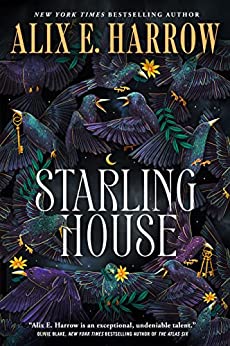 Starling House is a contemporary gothic fairy tale about an ugly old house full of secrets, the unfortunate man doomed to be its caretaker, and the desperate young woman who may hold the key to turning things around.
Starling House is a contemporary gothic fairy tale about an ugly old house full of secrets, the unfortunate man doomed to be its caretaker, and the desperate young woman who may hold the key to turning things around.
The story is more archetypal than super unique — heroine Opal struggles to make ends meet, and so takes a job cleaning Starling House so she can earn enough for her brother’s tuition. She’s scrappy and sarcastic, with enough street smarts for the entire family. Starling House caretaker Arthur is reclusive and beastly — almost literally: the story often compares him to the Beast from Beauty and the Beast, to the point that in one scene, he saves Opal from wolves and she dresses his wounds. The comparisons to Wuthering Heights also get heavy-handed; ‘Heathcliff’ must have been mentioned at least a dozen times.
But somehow, Harrow manages to make it all work. Underpinning the conflict is an evil developer who wants to purchase the land Starling House is on, and this developer’s minion flip-flops between bribing and blackmailing Opal for helpful intel. There’s also an old children’s tale from a woman who lived in the house centuries ago; a story about monsters who live beneath the grounds and are both fearsome and comforting for young girls.
This isn’t really the type of story I would normally pick up, yet Harrow’s writing drew me in. The author does a great job in interweaving fairy tale elements with contemporary real world struggles. And despite the archetypal associations for some characters, she’s also succeeded in creating compelling individuals to root for. I respect and admire Opal’s fierce determination to provide for her younger brother, and Arthur’s equally fierce determination to be the last person doomed to be Starling House’s caretaker. The way Opal and Arthur move through the conflict is very much within an eerie dreamscape, yet also very much infused with tangible trauma, and very real work needed to move past it.
Minor note but it matters: I also very, very much appreciate that both Arthur and Opal are described as unattractive. And not just in a ‘they feel ugly but everyone else sees how gorgeous they are,’ nor even in a ‘they’re ugly to everyone but each other,’ but that they actually seem unattractive on an objective level. As much as they are attracted to each other, and as much as they admire each other’s traits, neither Opal nor Arthur describes the other as beautiful or handsome. And among the other characters, even those who love them aren’t complimenting their looks. The whole ‘feels ugly but is actually gorgeous’ trope is used so often that I very much appreciate Alix E Harrow for letting these characters simply be ordinary-looking, perhaps even ugly. Because it isn’t just the gorgeous Hollywood look-a-likes who can save the day.
+
Thank you to Raincoast Books for an e-galley of this book in exchange for an honest review.
